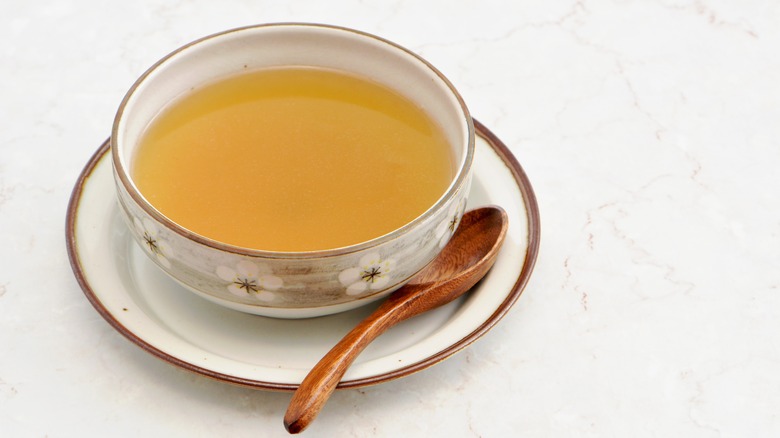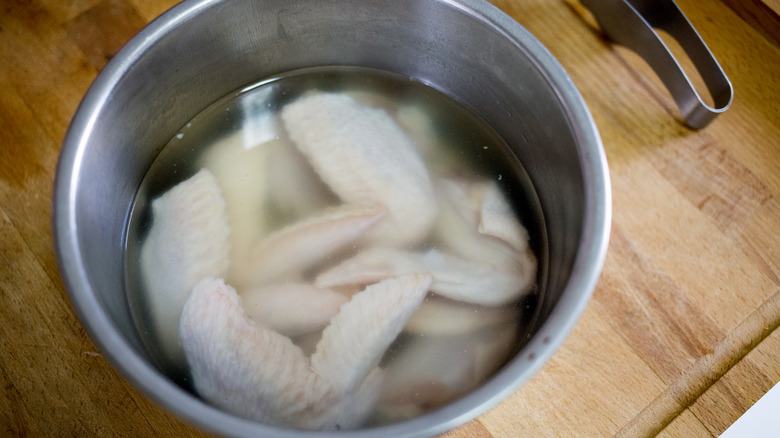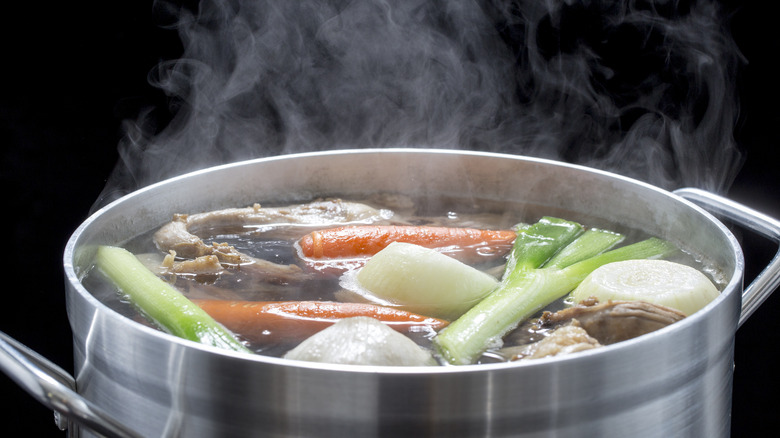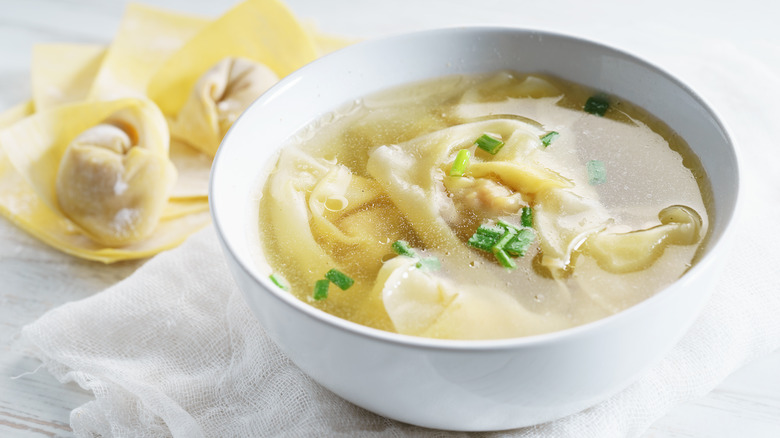The Trick For Keeping Chicken Broth Clear
Chicken broth is the main ingredient in many soups such as miso, chicken noodle, tortilla, and egg drop (per Kitchn); whereas chicken stock is used not only in soups, but as the base for risotto, chicken pot pie, cassoulet, and velouté sauce (via Escoffier). But what's the difference between stock and broth? According to Healthline, while these terms are often used interchangeably, broth is made from chicken meat, whereas stock is made from chicken bones. Broth is much lighter and yields more flavor, whereas stock has a thicker consistency and requires a longer cook time. To help you remember, think of stock as "stockier" than broth, because the collagen is released from the bones and creates a gelatinous texture.
This makes sense because chicken stock is typically used in thicker dishes like chicken pot pie, whereas the liquid in chicken noodle soup is made with broth. Have you ever noticed that your miso or noodle soups almost never have a foggy liquid? This isn't as important for dishes where you add broth to an opaque liquid, like in hot and sour soup, but if you want to be able to see the bottom of the bowl when you eat chicken noodle soup, here are some tips for keeping the broth clear.
Soak your chicken meat beforehand
According to The Woks of Life, a clear broth is achieved by proper preparation of ingredients. First things first, because broth uses meat, using a whole chicken with bones and all will aid in flavor, compared to buying chicken already cut. You should then soak your meat for at least an hour, changing the water one or two times as needed, and rinse clean when done to remove blood and any impurities that could fog up the broth. If you're in a pinch and don't have hours to spare, check out this video by The Frugal Chef for a quicker alternative, where she boils the chicken long enough for the skins to be removed, scrubs the parts of the chicken where the bones are exposed, and discards the water.
If you went with the soaking method, you'll want to add your meat to a pot, fill it with enough cold water to cover it, boil the meat for exactly one minute, and drain and rinse the meat thoroughly. Once you've removed the impurities, you will add in your vegetables. Make sure to chop your vegetables into 2-inch chunks because chopping them too fine can cause them to dissolve and create a cloudy liquid. Even if it seems like they're cut too large, four to five hours of simmering will still extract just as much flavor.
Simmer, don't boil
Simmering your chicken broth instead of boiling is important, as lower heat prevents the fat content in the meat from emulsifying and thickening the liquid too much, per Serious Eats. Therefore, a gentle simmer should read 205 degrees Fahrenheit on a thermometer. If you don't have a thermometer to check the water temperature, Serious Eats has a good rule of thumb for checking its appearance. The liquid should be bubbling slowly. If there's no bubbling, the heat is turned down too low. If there's too much movement, this could disturb the liquid, which reduces the liquid faster and causes it to lose clarity.
When your broth is done simmering, Joybilee Farms recommends straining the liquid through a fine-mesh sieve. A fine-mesh sieve is key because it removes even small granules that a colander can't. From there, you'll want to pick the meat off the bones and return the meat and strained liquid back to the pot. Then, simmer the mixture uncovered until it has reduced by half, then strain again through a fine-mesh sieve for a super clear, concentrated, protein-rich broth.
Put your broth to work
Now that you've mastered the art of a clear broth, it's time to use it! If you've ever heard of consommé, it's a clear broth within French cuisine that is similarly prepared using chicken broth except it uses egg whites to help purify the liquid, and is squeezed through cotton cloth (via Masala Herb). It's often served by itself as an appetizer, as chicken broth easily can be, too. However, chicken broth is packed with umami and adds an unexplainably delicious component to dishes, making it an ingredient that will only elevate, never take away.
Homemade chicken broth can add a special flare to dishes like shortcut chicken and dumplings or chicken pot pie pasta. You can also try not-so-obvious ideas like butternut squash soup, skillet chicken and orzo, or even seafood gumbo. However, if you want to show off the hard work you put in to create such a beautiful, silky, clear broth, wonton or chicken noodle soup is the way to go.
Lastly, it's important to store your broth properly so that you can extend its life and continue to utilize it regularly. Woks of Life states that broth can be stored in an airtight container in the refrigerator for up to 7 days, and in the freezer for up to 6 months. However, be careful not to overfill the airtight containers if you're storing the broth in the freezer, as when frozen, liquids expand and could result in a mess.



